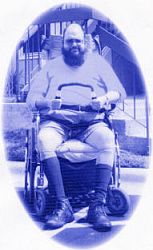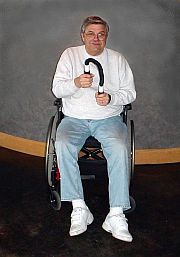Wheelchair Exercises For Fitness And Confidence Details
Qigong (Pinyin), ch'i kung (Wade-Giles), and chi gung (Yale) are English words for two Chinese characters: qì (氣) and gōng (功).Qi (or chi) is usually translated as life energy, lifeforce, or energy flow, and definitions often involve breath, air, gas, or relationship between matter, energy, and spirit.[6] Qi is the central underlying principle in traditional Chinese medicine and martial arts. Gong (or kung) is often translated as cultivation or work, and definitions include practice, skill, mastery, merit, achievement, service, result, or accomplishment, and is often used to mean gongfu (kung fu) in the traditional sense of achievement through great effort. (see MDBG dictionary entry) The two words are combined to describe systems to cultivate and balance life energy, especially for health.[1]
Although the term qigong (氣功) has been traced back to Taoist literature of the early Tang Dynasty (618-907 AD), the term qigong as currently used was promoted in the late 1940s through the 1950s to refer to a broad range of Chinese self-cultivation exercises, and to emphasize health and scientific approaches, while de-emphasizing spiritual practices, mysticism, and elite lineages.[7][8][9]istory
Main article: Qigong history
With roots in ancient Chinese culture dating back more than 4,000 years, a wide variety of qigong forms have developed within different segments of Chinese society:[10] in traditional Chinese medicine for preventive and curative functions,[11] in Confucianism to promote longevity and improve moral character,[1] in Taoism and Buddhism as part of meditative practice,[5] and in Chinese martial arts to enhance fighting abilities.[8][12] Contemporary qigong blends diverse and sometimes disparate traditions, in particular the Taoist meditative practice of "internal alchemy" (Neidan 內丹术), the ancient meditative practices of "circulating qi" (Xing qi 行氣) and "standing meditation" (Zhan zhuang 站桩), and the slow gymnastic breathing exercise of "guiding and pulling" (Tao yin 導引). Traditionally, knowledge about qigong was passed from adept master to student in elite unbroken lineages, typically with secretive and esoteric traditions of training and oral-mind transmission.
Qigong (Pinyin), ch'i kung (Wade-Giles), and chi gung (Yale) are English words for two Chinese characters: qì (氣) and gōng (功).Qi (or chi) is usually translated as life energy, lifeforce, or energy flow, and definitions often involve breath, air, gas, or relationship between matter, energy, and spirit.[6] Qi is the central underlying principle in traditional Chinese medicine and martial arts. Gong (or kung) is often translated as cultivation or work, and definitions include practice, skill, mastery, merit, achievement, service, result, or accomplishment, and is often used to mean gongfu (kung fu) in the traditional sense of achievement through great effort. (see MDBG dictionary entry) The two words are combined to describe systems to cultivate and balance life energy, especially for health.[1]
Although the term qigong (氣功) has been traced back to Taoist literature of the early Tang Dynasty (618-907 AD), the term qigong as currently used was promoted in the late 1940s through the 1950s to refer to a broad range of Chinese self-cultivation exercises, and to emphasize health and scientific approaches, while de-emphasizing spiritual practices, mysticism, and elite lineages.[7][8][9]istory
Main article: Qigong history
With roots in ancient Chinese culture dating back more than 4,000 years, a wide variety of qigong forms have developed within different segments of Chinese society:[10] in traditional Chinese medicine for preventive and curative functions,[11] in Confucianism to promote longevity and improve moral character,[1] in Taoism and Buddhism as part of meditative practice,[5] and in Chinese martial arts to enhance fighting abilities.[8][12] Contemporary qigong blends diverse and sometimes disparate traditions, in particular the Taoist meditative practice of "internal alchemy" (Neidan 內丹术), the ancient meditative practices of "circulating qi" (Xing qi 行氣) and "standing meditation" (Zhan zhuang 站桩), and the slow gymnastic breathing exercise of "guiding and pulling" (Tao yin 導引). Traditionally, knowledge about qigong was passed from adept master to student in elite unbroken lineages, typically with secretive and esoteric traditions of training and oral-mind transmission.
Wheelchair Exercises For Fitness And Confidence
Wheelchair Exercises For Fitness And Confidence
Wheelchair Exercises For Fitness And Confidence
Wheelchair Exercises For Fitness And Confidence
Wheelchair Exercises For Fitness And Confidence
Wheelchair Exercises For Fitness And Confidence
Wheelchair Exercises For Fitness And Confidence
Wheelchair Exercises For Fitness And Confidence
Wheelchair Exercises For Fitness And Confidence
Wheelchair Exercises For Fitness And Confidence
Wheelchair Exercises For Fitness And Confidence
Wheelchair Exercises For Fitness And Confidence
Wheelchair Exercises For Fitness And Confidence
Wheelchair Exercises For Fitness And Confidence
Wheelchair Exercises For Fitness And Confidence
Wheelchair Exercises For Fitness And Confidence
Wheelchair Exercises For Fitness And Confidence
Wheelchair Exercises For Fitness And Confidence
Wheelchair Exercises For Fitness And Confidence
Wheelchair Exercises For Fitness And Confidence
Wheelchair Exercises For Fitness And Confidence




















No comments:
Post a Comment